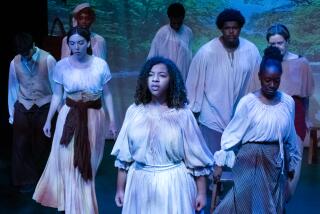BOOK REVIEW / FICTION : An Unspoken Homage to Two Men Fuels a Forbidden Love to Another : HOLLY: A Novel <i> by Albert French</i> ; Viking $21.95, 307 pages
- Share via
Perhaps the best way to characterize Albert French’s second novel also gives its plot away. To those who know their Shakespeare, at least: The central romantic relationship in “Holly” can be summed up as “She lov’d me for the dangers I had pas/ And I lov’d her that she did pity them.”
The love between Holly Hill and Elias Owens, which takes place in 1944, is as forbidden as that between Romeo and Juliet, to cite a different Shakespeare play, but in many ways makes more sense, for Elias is everything Holly’s other would-be boyfriends are not: mature, talented, resolute, accepting.
To the white population of Supply, N.C., Elias’ being “colored,” not to mention one-armed, makes him almost subhuman, but Holly comes to know that the very things for which local whites condemn Elias give him depth and distinction.
Interracial love stories tend toward sentimentality for all kinds of reasons, among them the kid-glove treatment such relationships commonly require and the easy, predictable fault lines between good and bad.
French, author of the well-reviewed 1993 novel “Billy,” avoids most of the obvious pitfalls, mainly because he gives Holly room to grow--more than half the book--before introducing Elias.
At the book’s opening, Holly is engaged to a young soldier at war in the Pacific, but it’s soon apparent that she’s pledged herself too soon, that she wants to experience more of life before settling down. With her girlfriend Elsie she starts to play the field, flirting with a disreputable Supply boy, hitting the local port’s nightspots with visiting sailors, now and then getting a little drunk and a little wild.
She doesn’t write her fiance, Billy, but hasn’t forgotten him, either; indeed, she is reminded of him every day through her brother Bobby, recently returned from the Pacific himself with a Purple Heart and a damaged brain.
Holly’s life changes, though, when she learns of Billy’s death in a bombing, soon after she decides to send him a Christmas card. She’s now frighteningly free, as well as deeply guilt-ridden--two things that explain her attraction to Elias, whom she meets at the creek dividing the white section of Supply from the black.
French overplays Elias’ romantic attractiveness--Holly discovers him at work on a landscape painting, an art he took up after war duty cost him an arm and a music career--but he does contrast dramatically with Holly’s callow, shallow friends.
Elias is her ticket out of Supply, certainly, but he also represents Holly’s unspoken homage to Bobby and Billy, a recognition that casualties of war should be universally honored, not selectively spurned.
Although the romance between Holly and Elias is the high-profile relationship in the novel, the more compelling is that between Holly and Elsie. The two are best friends, each other’s shadows, happy to share clothes, cigarettes, secrets, and not above fierce quarrels and bouts of not-so-good-natured name-calling.
French must have had an older sister, one suspects, or a teen-age daughter of his own: He evokes adolescent patter beautifully, the teasing and posing, the complaining and braying and sulking.
The essential difference between the two young women, of course, is that Holly crosses the color bar alone, rending the friends’ shared past--in Elsie’s eyes, at least--meaningless, even shameful.
“Holly” is a moral fable, to be sure, but French has told the story with grace and feeling, and--more significantly, perhaps--without preachiness or rancor.
More to Read
Sign up for our Book Club newsletter
Get the latest news, events and more from the Los Angeles Times Book Club, and help us get L.A. reading and talking.
You may occasionally receive promotional content from the Los Angeles Times.








